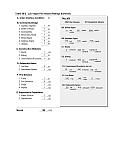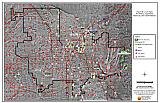26.0 Las Vegas
26.1 Risk and Hazard Assessment
Las Vegas is located in central Clark County. The community hazard assessment resulted in classifying Las Vegas in the Low Hazard category (30 points). The low rating is primarily attributed to good access, adequate defensible space, sparse wildland fuels, fire resistant building materials, and sufficient fire suppression resources. A summary of the conditions that contributed to the hazard rating for Las Vegas is included in Table 26-2 at the end of this section. The Las Vegas community boundary is shown in Figure 26-1.
26.1.1 Community Design
The area surrounding Las Vegas is a classic wildland-urban interface condition, with a clear line of demarcation between building structures and wildland fuels. Wildland vegetation typically does not continue into the development areas. Two-thirds of the homes were on lots of less than one acre in size; the rest were on parcels of one to ten acres in size.
- Access: Las Vegas is accessed via Interstate 95, Interstate 93, Interstate 15, and numerous state routes. Secondary roads are generally wide paved two-lane roads with adequate room for fire suppression equipment to maneuver.
- Signage: Street signs are visible on approximately ninety percent of the roads in the interface areas and residential addresses are visible on about 75 percent of the homes.
- Utilities: Utilities are both above and below ground. Utility right-of-ways are well maintained and pose a low ignition risk.
26.1.2 Construction Materials
All of the homes in the interface were built with non-combustible roofing and siding materials.
Only three percent of the homes observed in the community had unenclosed balconies, porches, decks or other architectural features that create drafts and provide areas where sparks and embers can smolder and rapidly spread fire if the home ignites.
26.1.3 Defensible Space
Ninety-two percent of the homes observed in the interface meet the minimum requirement for defensible space landscaping to minimize property damage or the risk of loss to the home during a wildfire.
26.1.4 Suppression Capabilities
Wildfire Protection Resources
The Las Vegas Fire Department (LVFD) has fifteen stations throughout the city staffed by 600 career firefighters. Automatic aid is available from Clark County Fire Department and North Las Vegas. The closest engine will respond to the fire. Mutual aid is provided by Nellis Air Force Base and the Bureau of Land Management.
In the city limits of Las Vegas, there is no formal first alarm brush fire dispatch because of the very limited brush within the city limits. Normal dispatch to a brush or grass fire within the city would be one engine (Gammon 2004).
The Las Vegas Fire Department is primarily equipped and trained to respond to urban incidents and emergencies. Specialized equipment and personnel trained in standard operating guidelines for wildland fire suppression in the interface currently comes from mutual aid agencies.
Water Sources and Infrastructure
Water available for fire suppression in Las Vegas includes fire hydrants within 500 feet of structures with minimum flow capacities of 500 gpm.
Fire Protection Personnel Qualifications
Las Vegas Fire Department firefighters are trained to the State of Nevada Fire Marshal Firefighter I and II and some are trained to EMT I.
Work Load
The Las Vegas Fire Department responds to approximately 68,000 calls annually. Approximately 82 percent are emergency medical calls. Occasionally they are called to small grass fires but they are rarely involved in wildland firefighting.
Financial Support
Financial support for the Las Vegas Fire Department comes from the City General Fund.
Community Preparedness
The City of Las Vegas has an Emergency Operations Plan. This plan is prepared by the Emergency Management Office of the Fire Department and is updated as needed.
The Las Vegas Fire Department reviews development plans to ensure compliance with the 2003 NFPA-1 fire code.
26.1.5 Factors Affecting Fire Behavior
The City of Las Vegas is characterized by flat terrain. There is very little brush within the city limits. The vegetative community around the Las Vegas area is Mojave Desert shrub. Fuels consist of annual grasses and bursage, which was considered a low fuel hazard. In the Las Vegas Wash, the fuel hazard is dangerously high, estimated at ten to twenty tons per acre. The fuel load consists of tamarisk ten to twenty feet tall, mesquite up to twelve feet tall, and creosote bush and fourwing saltbush up to six feet tall. Urban garbage dumps increase the fuel load in certain areas. There is a history of fire occurrences in the Las Vegas Wash.
26.1.6 Fire Behavior Worst-case Scenario
The worst-case for a wildland fire would occur along the Las Vegas Wash in the Desert Wetlands Park. This area contains the greatest fuel loading in the Las Vegas-Henderson area. A fire in the late afternoon in the summer would be wind driven, influenced by predominately south-southwest winds or erratic winds from thunder storm activity. This would be a rapidly moving high intensity fire with the potential for hazardous materials releases from garbage dumps. Structures west of the wash would be threatened from a wildfire if erratic winds shifted and came from the east. A fire in the Las Vegas Wash represents one of the highest safety concerns for firefighters in Clark County. Clark County firefighters do not receive regular wildland fire training, they are not issued wildland fire protective equipment or fire shelters, and there are no standard operating guidelines for wildland firefighting.
The worst-case scenario wildland fire outside of the Las Vegas wash would occur during a year with above normal precipitation and high annual grass and forb production. High amounts of dried grasses could be ignited and spread fire through the shrubs under high wind conditions. Existing good defensible space conditions and rapid initial attack should be sufficient to control a fire under these conditions before structures would be threatened.
26.1.7 Ignition Risk Assessment
Las Vegas has a low wildfire ignition risk potential. While a history of ignitions was reported, the low, sparse brush in and around the community effectively prevents ignitions from developing into wildfires of significant size.
26.2 Risk and Hazard Reduction Recommendations
The hazard reduction recommendations Las Vegas focus on weed control and firefighter training.
26.2.1 Defensible Space Treatments
Property Owners
- Homeowners should ensure their address is visible from the road in at least four-inch reflective numbers.
- Clear all vegetation and combustible materials around propane tanks for a minimum of ten feet.
- Mow and maintain weeds and grass within thirty feet of structures to a height of no more than three inches to prevent dried annual grasses and weeds from collecting against homes, vehicles, and fences.
26.2.2 Fire Suppression Resources and Training
Las Vegas Fire Department
- Provide all firefighters with basic wildland fire training and equipment as described in the National Wildfire Coordinating Group (NWCG) Wildland and Prescribed Fire Qualification System Guide (PMS 310-1). Provide annual wildland firefighting refresher training and fire shelter training.
26.2.3 Fuel Reduction Treatments
Las Vegas Fire Department
- Establish and enforce a brush clearance program to reduce fuel hazards in the few areas where they occur within the Las Vegas community boundary.
26.3 Summary of Recommendations
| Involved Party | Recommended Treatment | Recommendation Description |
|---|---|---|
| Property Owners |
Defensible Space | Mow and maintain weeds and grass within thirty feet of structures to a height of no more than three inches to prevent dried annual grasses and weeds from collecting against homes, vehicles, and fences. Clear all vegetation and combustible materials around propane tanks for a minimum of ten feet. Ensure that address signs are clearly visible from the access road. |
| Las Vegas Fire Department | Fire Suppression Resources and Training | Provide all firefighters with basic wildland fire training and equipment. |
| Fuels Reduction | Establish and enforce a brush clearance program to reduce fuels in the few areas where they occur within the city. |
Table 26-2. Las Vegas Wildfire Hazard Rating Summary |
 |
Figure 26-1 Las Vegas Fire History, Suppression Resources, and Critical Features |
 |
